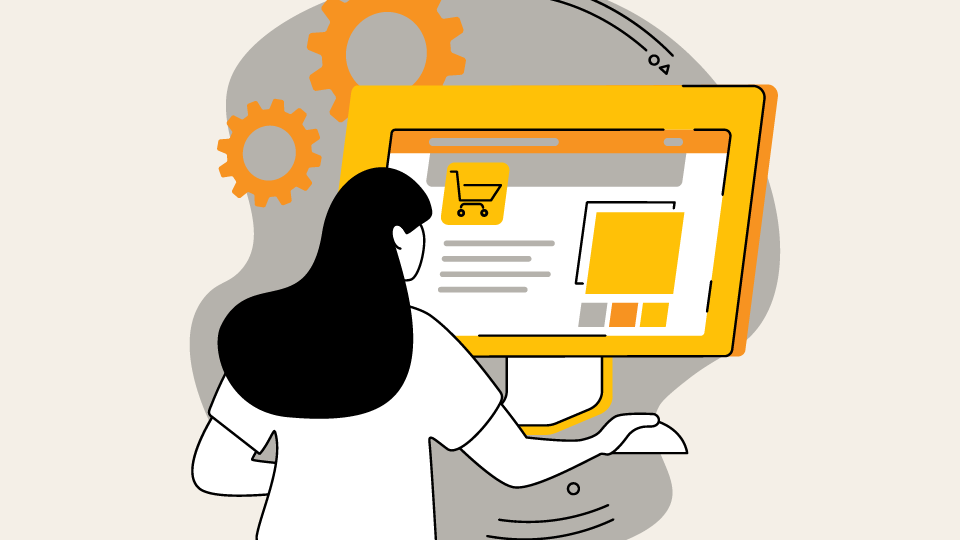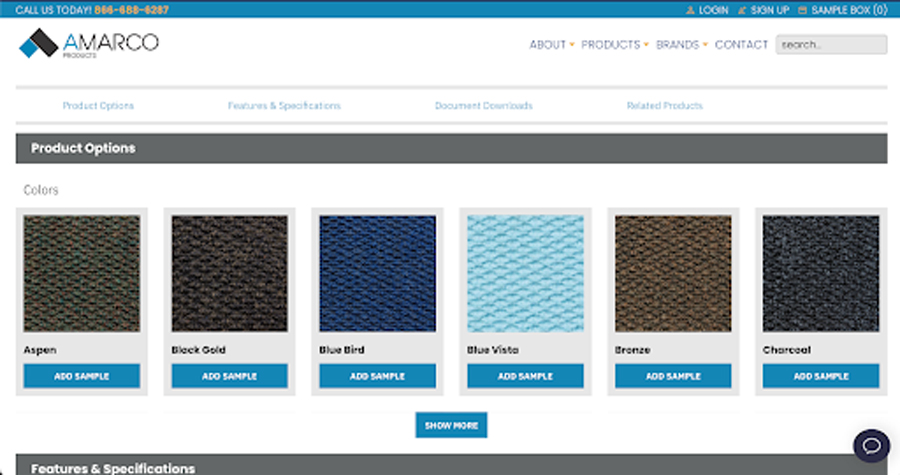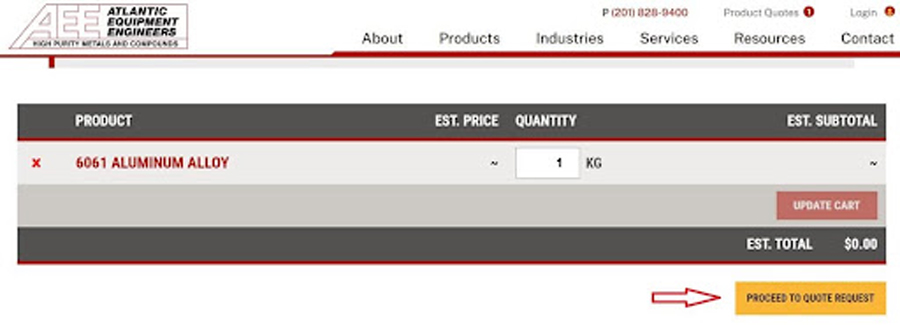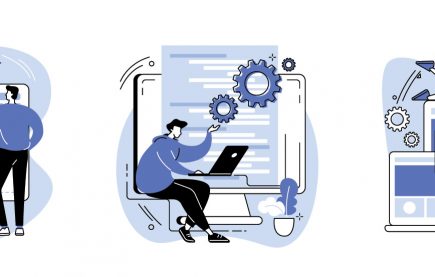
Ecommerce Website Development: The Good, the Bad, and the eCom
According to a study by Statista, 23% of all retail purchases are expected to take place online by 2027.

This means that now is an excellent time to invest in ecommerce website development. But what does that mean? What are its benefits and hurdles, and what are some of the best ecommerce platforms you can use today?
If those are the questions on your mind, keep reading as we explore the ins and outs of ecommerce website development.
Many of the concepts we discuss in this post will work for all sectors. However, here at Lform, we’re focused on B2B website design so we will consider ecommerce website development primarily through that lens.
What is Ecommerce Website Development and Do You Need It?
Ecommerce website development is exactly what it sounds like; building a website with ecommerce capabilities, allowing businesses or online retailers to sell goods or services online. While it’s possible to build a basic ecommerce website yourself with little know-how, we always recommend going to the professionals for the best results.
If you’re considering hiring an ecommerce web design firm to build your site, the first question to ask yourself is: do I need a website with ecommerce capabilities?
You might not! If your target audience doesn’t tend to order online or tend to order highly customized products directly, an ecommerce website might not be the most appropriate tool for you.
Likewise, if you rely on distributors to do the ecommerce side of things for you, then ecommerce might not fit within your current sales strategy. Also, an ecommerce site might not be a priority if you do not have a large enough team to manage the site and the logistics of running an ecommerce arm (such as logistics, shipping, inventory tracking, and customer service).
The Benefits of Custom Ecommerce Development
There are numerous benefits to having a custom ecommerce website built. Here are some of the ways such a website can help your business grow.
1. Greater Control, Higher Profits
The first and most obvious benefit of developing a custom ecommerce site for your online business is it allows you to sell directly to your customers. This cuts out the “middleman” and increases your profit margin.
Many B2B companies make use of distributors or external sales teams. Though effective, this can be costly and at times inefficient. By removing these representatives from the equation, you will be in full control of your products and profits.
Using a custom ecommerce website to sell your products directly also means you have full power over how your products are presented and marketed.
2. Makes Your Systems Work Together
Technology allows you to link your ecommerce website with your enterprise resource planning (ERP) and customer relationship management (CRM) systems. Many B2B companies already have ERP systems in place (Netsuite is a popular tool). By linking your ERP system with your custom ecommerce website, you can track pricing and inventory in real time in one central location.
Meanwhile, linking your ecommerce website to your CRM system allows you and your sales team to manage customer relationships, resolve any issues, and market your products to your existing customer base.
If your business has complex rules, integrating these into your ecommerce system can reduce overheads associated with the necessary sales and administrative processes.
What if you do not already have ERP or CRM systems or the ones you have are no longer fit for purpose? Well, investing in an ecommerce website can be an impetus to implement systems that will better serve your business. This will unify your data and help you scale up.
3. Automates Complex Sales Processes
Depending on what you sell, your sales process might require significant customer input. For example, customers might need to specify material types, measurements or square footage, product formats, or other considerations. A robust ecommerce website can simplify this process for both your customers and your sales team.

This type of automation also allows your customers to spec out their products, assessing pricing and logistical considerations efficiently, with little to no input from your staff required. That’s what Amarco does with their website above.
4. Enhances the customer experience
An ecommerce system gives you an automatic product catalog for your customers to browse. By allowing customers to browse and find products that meet their needs, you will save your sales team’s time and generate a good conversion rate without too much effort.
If you have a lot of products or products with a variety of specifications, product filtering is essential. Filtering helps your customers identify the products that will fulfill their needs without requiring your sales team to know the specifics of every item you stock (or continually spend time looking things up).
This also makes for a less frustrating process for your customers, allowing them to research their options on their own time and putting control over the process in their hands.
5. A Tool for Your Sales Team
Your website can become a valuable tool for your sales team to utilize. By keeping documents, features, and product specifications in one place, your sales team can go to the website to source information or assist customers in finding the right product.
If you do not have an ERP system, your ecommerce site can also be used as a quick quote system, allowing your team to generate pricing estimates for customers in moments.
You can implement granular tracking and analytics on your website, which can provide a goldmine of information. You’ll be able to see which products are getting the most attention, identify areas that are not performing so well, and perform A/B testing to ascertain which ways of presenting products are most effective.
6. Helps You Create Different Customer Groups
Many companies in the B2B space serve different customer groups at different price points. A sophisticated ecommerce website can account for this through a log-in system, allowing you to categorize customers and show them personalized pricing.
You can assign each new customer a group based on predefined parameters. For example, perhaps you want to show new customers introductory deals or reward long-standing customers with a steeper discount.
If you serve both wholesale and retail customers, you can also use this system to serve them through the same platform rather than investing in separate systems.
7. Unify Distributor and Internal Products
Perhaps you, like many ecommerce businesses, sell products from distributors in addition to in-house products. If so, you can use your custom ecommerce website to present all these products to customers in a unified manner.
With some careful planning and marketing know-how, you can also employ strategies to effectively promote internal versus distributor products.
The Hurdles in Developing an Ecommerce Website
Despite its many advantages, developing and running an ecommerce website also comes with some hurdles. Here are a few of the hurdles we, and our B2B clients, encounter most often.
Users Expect to “Check Out”
In general, when customers use an ecommerce website, they expect to be able to “check out” once they’ve selected their products. Depending on the company’s business model, this isn’t always possible.
Some businesses cannot simply open an online store and sell products. This might be due to regulatory considerations, verification requirements, logistical issues, or other factors. One effective solution if this is a problem for your business is to deliver an eCommerce-like experience in the form of “requesting a quote” as opposed to a traditional “checkout” option.
Here is an example from Atlantic Equipment Engineers:

When a customer clicks the “Proceed to Quote Request” button, the system can hand them to a member of your sales or customer accounts team to close the sale.
The advantage of this method is you can integrate this eCommerce-like website into your CRM and ERP systems, enjoying the benefits this joined-up approach brings to your business and sales processes.
ERP Investment Expense
In the majority of cases, a strong ERP system is likely to be needed for ecommerce to succeed in the long run. This is particularly true if your company has a lot of inventory, a large product catalog, or many employees.
However, ERP systems are a serious investment. They are expensive and have a concerningly high rate of failure due to a large number of factors that can potentially go wrong.
ERP integrations require an organization to re-examine every aspect of its business processes to automate them as much as possible. This is often a time-consuming and painstaking process but, if successful, it can pay big dividends in the long-term.
Bear this in mind when you are considering setting up an ecommerce website, as it is an expense and degree of hassle you will need to be prepared for.
Shipping
Shipping is the final leg of the sales process, but many companies overlook this aspect of their ecommerce presence. If everything you sell is dispatched via drop-shipping, this is not a concern, but otherwise, it is a major consideration.
Shipping carriers charge according to both the weight and dimensions of items. To accurately estimate shipping costs for your customers, you will need to know the weight and dimensions of each product once it is boxed up for shipping. You do not want to either under-charge and lose money, or overcharge and lose customers.
If you ship products in their own boxes, knowing this information becomes easier. But if products are packaged in variable ways, the final weight and dimensions of each box won’t be known until the order is ready to leave your warehouse.
Some ERP systems offer tools to manage this problem, and some SaaS systems (PaceJet is one example) have this functionality built-in or available as a plugin.
If your products are large or often sold in bulk, you’ll need to factor in less-than-load (LTL) shipping, which comes with its own complications.
You might need to invest in appropriate software or reexamine your business processes to solve your organization’s shipping challenges if you do decide to go ahead with an ecommerce website.
Significant Overhead
Developing an ecommerce website is a time-consuming and skilled process. It requires a lot of planning time, design expertise, and of course development. You can expect to pay a substantial sum of money for a strong ecommerce website.
The overheads do not stop when your website is launched, either. It will need to be maintained internally, and bugs or issues may arise occasionally. You will likely need a dedicated person in-house to manage your website as well as a trusted web development partner.
In addition, if your business has complex processes or has not adequately systemized everything, you will need to spend time coming up with logic-based rules to implement into your new ecommerce system.
Customer Service
Businesses live or die by the quality of their customer service. The best ecommerce experience in the world won’t save you if you cannot properly address customer concerns and needs as they arise.
There will always be a few customers who run into problems, and you need to be prepared to address these. This means baking in processes for returns, cancellations, credit card chargebacks, and so on. It is also essential to have a strong fraud mitigation system in place.
Customers trust you with their personal information, not to mention their money when they buy from you. If you are not responsive to their concerns, they will lose trust in you and will never patronize your business again.
Best Platforms for Ecommerce Websites
Custom ecommerce website development is not the only option. You can also build your store on top of popular ecommerce platforms. Of course, these platforms won’t give you as much flexibility as having a custom website. They may also fail to address unique business goals and needs. However, they are likely to be cheaper than building a custom ecommerce website.
Here are a few of the major ecommerce website platforms on the market if you’re considering this option:
1. Shopify

Shopify is perhaps the biggest name in ecommerce, and just about everyone has heard of it. Shopify is a SaaS ecommerce system designed to meet the needs of the vast majority of B2C businesses.
Shopify Pros
- Shopify is simple to use and manage even if you have very limited technical knowledge. Its shopping cart and checkout flow systems are easy and user-friendly for customers.
- It offers several professional-looking templates that can be customized with your branding without the need for custom development.
Shopify Cons
- Shopify’s simplicity means that it does not leave much room for complex business rules or scenarios. For example, it does not have the functionality to enable the customer group pricing we discussed above.
- It also scales poorly if you have over 1000 products or variations, and allows for limited variation options.
- You will be hit with steep transaction fees unless you use Shopify’s inbuilt payment system.
In general, Shopify is ideal for an average merchant selling a small inventory of general products.
2. BigCommerce

Though not quite as well known, BigCommerce is a direct competitor to Shopify. However, it offers a lot more functionality at the same price point.
BigCommerce Pros
- BigCommerce has more impressive inbuilt functionality than Shopify. For example, it allows customer group pricing and offers more powerful sales tools.
- BigCommerce also scales much better than Shopify, particularly if you have a larger inventory.
- It can be much more cost-effective since it does not charge a fee on each transaction.
BigCommerce Cons
- BigCommerce has inbuilt order sales limits on each plan ($50,000 on the most basic plan, for example). While these limits may not be problematic for B2C retailers selling general products, a B2B company can run up against these limits very quickly.
- BigCommerce’s library of themes is not quite as extensive as Shopify’s, so you may have to compromise more on how you want your site to look.
- The abandoned cart system is only available on higher-priced plans. Since around 81% of carts are abandoned according to SaleCycle, having this functionality can be a big advantage.
3. WooCommerce

WooCommerce is the number one ecommerce software on the internet. It uses WordPress as its underlying technology, which powers almost 40% of the entire web according to TechJury.
WooCommerce Pros
- WooCommerce is fairly comprehensive and can handle both simple and complex ecommerce scenarios straight out of the box.
- It can be customized via an extensive library of plugins to address specific business needs or meet the requirements of complex business rules.
- It also integrates well with many third-party shipping and credit card systems.
WooCommerce Cons
- WooCommerce relies on WordPress which, though ubiquitous, comes with its own idiosyncratic development processes.
- WooCommerce does not scale well for very large inventories (5000+ products)
- Some extensions require ongoing subscriptions, which pushes up the monetary overhead to maintain functionality.
4. Magento

Magento is by far the most advanced ecommerce system available on the market. It is the aircraft carrier of ecommerce systems: there’s not much it can’t do!
Magento Pros
- It can be customized extensively, allowing it to meet any business’s requirements and processes as well as align with your branding.
- Magento is also designed to accommodate inventories of literally any size. It can handle ten products or ten million products equally well.
Magento Cons
- Magento is expensive and comes with a very high maintenance overhead due to its complexity.
- Customizing Magento is complicated and time-consuming due to its architecture. It requires expertise to manage and customize, which can add to the cost even more.
- It is challenging for the average shop owner to manage due to its extensive settings and options. Nothing is simple in Magento, whether you’re adding products or processing orders.
Ecommerce Website Design Best Practices to Follow
Now that you understand the benefits of ecommerce website development, it’s time to talk a bit about design. Your customer’s perception is the reality you need to prioritize when designing your website. Why?
Because your website’s web design can impact your brand credibility by at least 75%. This means you’ll get more eyes on your products if you design everything just right. But if you don’t, well, you won’t get many — or any.
Here is a quick rundown on ecommerce website design best practices:
1. Prioritize User Experience
Bright colors, beautiful photos, and the best content management in the world mean nothing when potential customers can’t navigate your website or find the products they want. In fact, almost 60% of people abandon their purchases because of poor user experience (UX).
This means you need to keep UX at the forefront of your website design strategy. Here’s how to do that:
- Make sure your website is easy to use and has a consistent structure
- Simplify your site navigation
- Streamline checkout
- Add a search option so customers can find the products they want
- Offer several payment methods aside from credit/debit cards, such as accelerated methods like Google Pay, PayPal, and Venmo.
If you’re working with a website development company, make sure to discuss these design elements with them.
2. Don’t Skip Out on Trust Signals
When customers first land on your site, they want to know whether you’re legit. Unfortunately, most website designs skip out on trust signal integration. And that’s what you should never do.
Why?
Well, trust signals increase transparency, reduce customer anxiety, and build rapport between you and your customers — which is what helps you make sales. If you don’t add them, you will lose customers, even those who take a chance on you.
But how can you add them in? Here’s a short list:
- Use High-quality Images and Videos – Customers want to understand everything about a product they want to buy before checking out. And when they don’t get that experience, they bounce. So, use various site visuals to stop that from happening.
- Add Customer Reviews – New shoppers want to see why other people are buying from you and whether they have good things to say about your products. Customer testimonials help you use social proof to validate your brand value, build trust, reduce resistance, and encourage customers to buy your products.
- Link to Your Social Media – Your customers are going to get frustrated if they can’t connect with you anywhere except by email. This is where social media links become so important. They’ll make it easy for customers to connect with your customer support team. They’ll also assure shoppers that your brand is legit, which is the point of trust signal integration.
3. Optimize for Mobile
Online shopping happens on the mobile phone today. Mobile shopping accounted for over 60% (almost $2.2 trillion) of all ecommerce sales worldwide in 2023. This means ensuring your e-commerce website has a mobile-responsive design isn’t just a best practice — it’s a rule you need to follow.
Here’s what you need to do:
- Make sure your website is easy to navigate on mobile.
- Ensure your website loads quickly. Even a two-second delay can cost you hundreds of customers.
- Use easy-to-read fonts and buttons that are large and easy to tap.
- Eliminate invasive pop-ups because they lead to a poor UX.
- Make sure the checkout process is intuitive and straightforward.
Also, design everything according to the “think with your thumb” rule. If a customer can’t reach a button with their thumb, move it closer. A responsive website design also boosts your search engine optimization efforts, allowing you to generate more traffic and leads.
In Closing: Getting Started with Ecommerce Website Development
A great custom ecommerce website and robust implementation process will bring increased sales, happier customers, and better prospects for scaling your business upward. The website can help your business grow not just in profits and reach, but also in maturity by forcing you to integrate ERP and CRM systems that give your business the boost it deserves.
Developing an ecommerce website and implementing an ecommerce arm of your company is a challenging process. But once you overcome those challenges, you will reap the rewards and never look back. If you need assistance with this, get in touch with our team of talented developers. We’ll gladly listen to your unique business needs and help you come up with a fitting custom ecommerce website.



